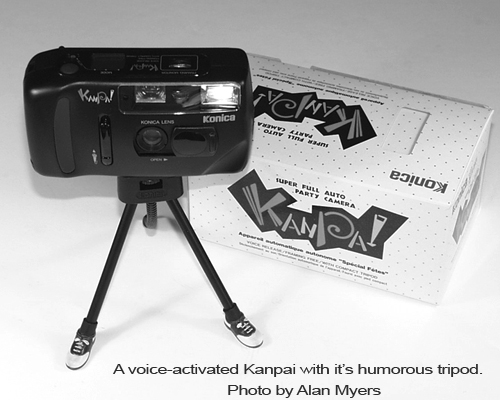Konica Kanpai

|
| Konica Kanpai camera and tripod image by Alan Myers (Image rights) |
Designed as a "party camera", the Konica Kanpai (or Konica Kanpa!), meaning "cheers" in Japanese, reacts to voices and tries to shoot the source of the sound. The camera itself is a basic fixed focus model with flash, but also a waist-level finder. The main attraction is its voice-activation, though. After adjusting to the ambient sound level, the camera reacts to loud voices or noises, indicated by a row of LEDs on the front. Standing on its funny tripod with basket shoes, it turns within a 45° angle toward the source of the sound and takes a picture automatically. As the model name implies, the intention is to take pictures when everyone at the table shouts "kampai", without user intervention. The Konica Kanpai was released in 1989, and cost 216 US dollars or 4 000 yen. It was sold in red and black colour, and a variation clad in a collage of the letters P, A, R, T, Y.
Specifications
- Lens: 34 mm f/5,6 (3 elements/3 groups)
- Focus: Fixed focus from 1,1 m to infinity; voice activated mode switches to close focusing (0,9–1,8 m).
- Shutter: 1–1/200 s. Electronic self-timer.
- Exposure: CdS cell, EV6–EV15,6
- Flash: Built-in, flash-matic exposure, automatically activated or forced. Can be turned off. Slow synchro up to one second. Range 1,1–3,3 m (ISO 100).
- Film transport: Motor wind and auto rewind.
- Power: 1 x 2CR5 6 V lithium battery.
- Dimensions & weight: 126x67x48,5 mm, 195 g (without battery).

|
| Konica Kanpai image by Hans Kerensky (Image rights) |
| Japan Camera Grand Prix | |
|---|---|
| Camera of the year
1984: Nikon FA | 1985: Minolta α-7000 | 1986: Canon T90 | 1987: Canon EOS 650 | 1988: Kyocera Samurai | 1989: Nikon F4 | 1990: Canon EOS 10 | 1991: Contax RTS III | 1992: Pentax Z-1 | 1993: Canon EOS 5 | 1994: Minolta α-707si | 1995: Contax G1 | 1996: Minolta TC-1 | 1997: Nikon F5 | 1998: Pentax 645N | 1999: Minolta α-9 | 2000: Canon EOS-1V | 2001: Minolta α-7 | 2002: Canon EOS-1D | 2003: Canon EOS-1Ds | 2004: Nikon D70 | 2005: Konica Minolta α-7 Digital | 2006: Nikon D200 | 2007: Pentax K10D | 2008: Nikon D3 | 2009: Canon EOS 5D Mark II | 2010: Olympus Pen E-P1 | 2011: Pentax 645D | 2012: Nikon D800 | 2013: Sony DSC-RX1 | 2014: Nikon Df | 2015: Canon EOS 7D Mark II | 2016: Sony α7R II | 2017: Olympus OM-D E-M1 Mark II | 2018: Sony α9 | 2019: Lumix S1R | 2020: Sony α7R IV | 2021: Sony α1 | 2022: Nikon Z9 | 2023: Sony α7R V Special Prize Editor | |